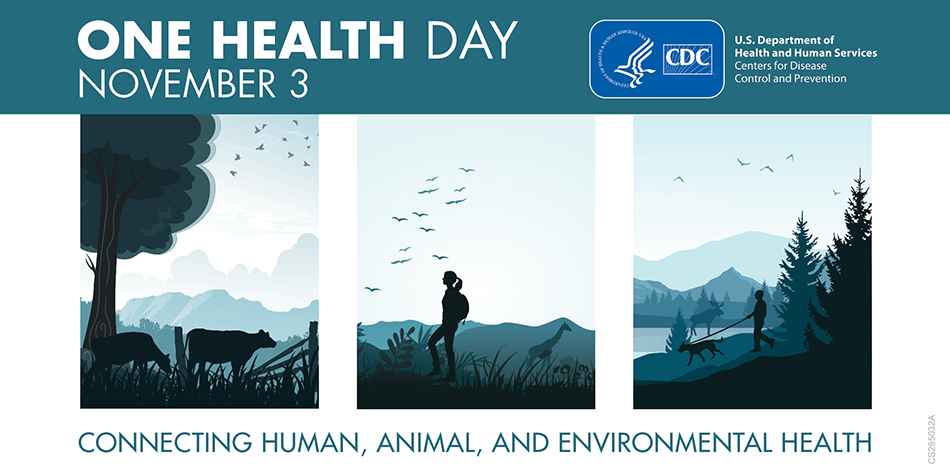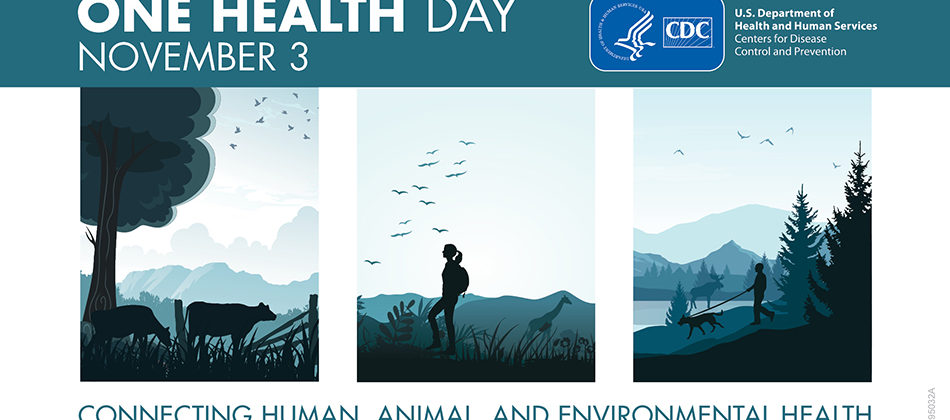The interconnectedness of people, animals, and the environment is known as “one health”. This concept provides a framework for experts in their respective fields, from wildlife researchers to medical practitioners, to solve societal issues collaboratively. A global one health approach to research, policy, and education improves our preparedness and response to emerging infectious diseases that originate from the natural world.
The novel coronavirus, SARS-CoV-2, was identified in China at the end of 2019. Since then, researchers have found that the virus is genetically related to coronaviruses specific to bats and there was likely an intermediary animal host that allowed for it to make the evolutionary leap to humans. Although 11 months have passed since the first confirmed infection, cases of COVID-19 are peaking in areas of the United States and other regions of the world.
Today (November 3rd) is One Health Day, a day recognized every year as a reminder that disease outbreaks, like the COVID-19 pandemic, can be mitigated or prevented when we understand the importance of interactions between people, animals, and the environment.

The World Organization for Animal Health reports that about 60% of emerging zoonotic diseases come from pathogens of animal origin. Further, scientists suggest that 1.7 million viruses are kept in populations of birds and mammals with about 50% having the ability to infect people if the opportunity arises. Despite knowing this, human activities that contribute to increased risk of “spill-over” events continue to take place in many areas of the world. The United States Agency for International Development (USAID) recently announced a new five-year, $100 million dollar project to address spill-over of zoonotic viruses. The cross-disciplinary approach will focus on assessing the risk and responding to spill over in high risk communities in several countries.
Spill-over is when infectious agents from wildlife and surrounding environment make their way into a human population over time. These events are more likely to occur when boundaries are broken down from degradation of the natural world. An example of this is deforestation of wooded areas that are important for deer, squirrels, birds, and other animals. Fragmentation of habitable areas leads to their invasion of surrounding communities, increasing the risk for direct and indirect disease transmission.
Tick-borne disease prevalence increasing in areas of the United States is a more specific consequence of spill-over caused by human practices. Research suggests that climate change and habitat disturbance both contribute to the expanding geographic range of ticks that transmit Lyme Borrelia, Babesia, Ehrlichia, and other tick-borne pathogens.
Conclusion
One health day reminds us of the framework scientists use to look at risk of spill-over events and what can be done to reduce their occurrence and impact.
References
Drake, J. (2020, 31 October). What is one health? Forbes. Available at: https://www.forbes.com/sites/johndrake/2020/10/31/what-is-one-health/?sh=6432e484134c
Benfield, C.T.O et al. (2020, 30 September). We must take a One Health approach to improve human pandemic infection control. The BMJ Opinion. Available at: https://blogs.bmj.com/bmj/2020/09/30/we-must-take-a-one-health-approach-to-improve-human-pandemic-infection-control/
USAID. (2020, 30 September). USAID announces new $100 million project to anticipate threats posed by emerging infectious disease. USAID.gov. Available at: https://www.usaid.gov/news-information/press-releases/sep-30-2020-usaid-announces-new-100-million-project-threats-emerging-infectious
Gibbens, Sarah. (2020, 29 October). Protecting land animals will mitigate future pandemics report says. National Geographic. Available at: https://www.nationalgeographic.com/environment/2020/10/protecting-land-animals-will-mitigate-future-pandemics-report-says/
Deem, S.L. & Brenn-White, M. (2020, June & December). One health – the key to preventing COVID-19 from becoming the new normal. Molecular Frontiers Journal. Available at: https://www.worldscientific.com/doi/pdf/10.1142/S2529732520400039


